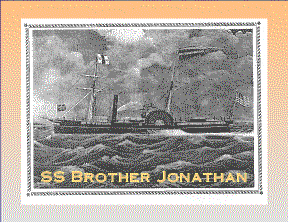They stated that even up untell the late 1890's the problem wasn't with getting powder it was the ability of companies here in the US to make the boilers any bigger , we just didn't have the tech to do it .
You would think that for a country supposable built on our iron industry we would have had more capabilities earlier .
:hmm:
Seems to me there were some relatively large boilers, and turrets, on the Monitor and the dozens of ironclads that followed her; and in the large steamships and paddlewheelers.
The following article from the Daily Alta California was located and transcribed by John Ireland:
Daily Alta California, March 3, 1851
New Steamship Brother Jonathan--A private letter from Edward Mills, Esq., of New York, speaking of the new and magnificent steamship Brother Jonathan, which is now preparing to sail for this port, says: She is one of the finest steamers ever built here and is equal to any other in point of speed - she has fine lines and great power - no boat has so much in proportion to her size. Her dimensions are 220 feet keel, 36 feet beam, 21 feet deep - solid floors, iron diagonal braces from coaged and kelson. In fact, she is as strong as wood, iron and copper can make her, and will only draw on the river 8 1/2 feet. Her cabins are well ventilated for warm climates, and the saloons finished with white enamel gold. The engine is 72 inch cylinder, 11 feet stroke, flue boiler 12 feet schell and 28 long; wheel 33 feet in diameter, 9 feet face, 30 inch bucket and 4 feet dip. She is the same power as the celebrated steamers Oregon, Vanderbilt and Bay State, and I know no reason why she should not have nearly even speed. I think she is worthy of the regards of the Californians.





